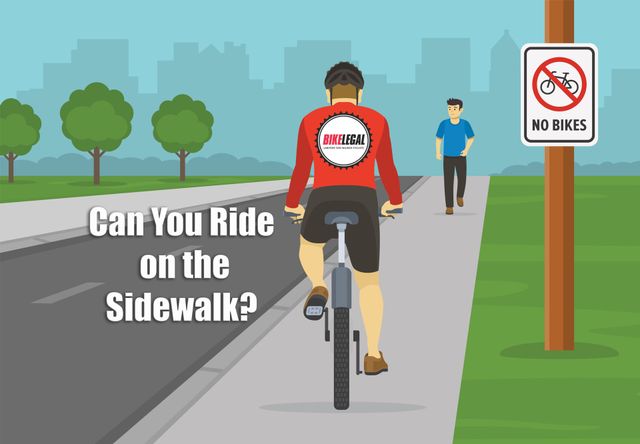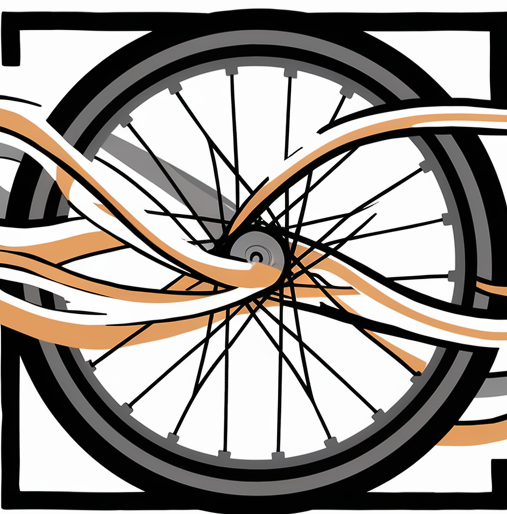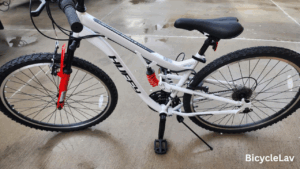No, you generally cannot ride a bicycle on the sidewalk. Laws vary by location, but many areas prohibit this for safety reasons.
Riding a bicycle on the sidewalk can seem convenient and safe. After all, sidewalks are for pedestrians, not fast-moving cars. But, many cities and towns have rules against it. These laws aim to protect pedestrians and reduce accidents. Sidewalks can be narrow, crowded, and not designed for bicycle use.
Riding on the road can sometimes feel risky, but it’s often the legal requirement. Understanding local laws helps you stay safe and avoid fines. So, what should you know about riding bicycles on sidewalks? Let’s dive into the specifics and explore the reasons behind these rules.
Bicycle Laws And Regulations
Bicycle laws vary widely across different regions. Understanding these laws ensures safety and compliance. Many cyclists wonder about riding on sidewalks. The answer often lies in specific local or state rules. Knowing these can prevent fines or accidents.
Local Ordinances
Local ordinances govern bicycle use on sidewalks. Each city may have unique rules. Some allow sidewalk riding, others forbid it. These laws often depend on pedestrian traffic. High pedestrian areas might restrict bicycles. Always check with local government websites. They provide the most current rules.
State And Federal Rules
State rules can also affect sidewalk riding. Some states have blanket laws covering sidewalk use. These laws might override local ordinances. It’s crucial to know your state’s rules. Federal laws rarely address bicycles on sidewalks. They focus more on road safety and infrastructure. Always prioritize safety and awareness.

Credit: www.bikelegalfirm.com
Why Sidewalk Cycling Matters
Navigating sidewalks on a bicycle is crucial for safety and accessibility. Cities have varied rules, but understanding local laws helps avoid fines. Sidewalk cycling offers a safer option for beginners and children, promoting cycling in urban areas.
Bicycling on sidewalks often sparks debate, yet its significance can’t be overstated. For many, sidewalks offer a safer and more convenient option compared to bustling roads. Understanding why sidewalk cycling matters involves looking at its impact on accessibility and safety, which are crucial for everyday cyclists. ###Convenience And Accessibility
Biking on sidewalks can make your journey much more convenient, especially in urban areas. Busy roads can be intimidating, but sidewalks provide a calmer space for those who prefer a slower pace. Imagine a parent guiding their child on a sidewalk, feeling safe from the fast-moving traffic. Sidewalk cycling can also be a boon for people who are not confident on the road. It ensures more people can access biking as a form of transportation or exercise. This increased accessibility can promote healthier lifestyles and reduce reliance on cars. ###Safety Concerns
Safety is a significant concern when it comes to sidewalk cycling. While it offers protection from vehicles, it can pose risks to pedestrians. Navigating crowded sidewalks requires caution and respect for others sharing the space. Some cities have laws against sidewalk cycling, while others allow it under certain conditions. It’s crucial to know the local rules to avoid fines and ensure everyone’s safety. Would you prioritize safety over convenience, or do you think there’s a balanced approach? Personal experiences can highlight these safety concerns. I once had a close call with a pedestrian while cycling on a busy sidewalk. It taught me the importance of being vigilant and respectful, reinforcing the need for clear guidelines and shared understanding. Balancing convenience with safety is key to making sidewalk cycling work for everyone. Your choices can greatly impact not just your journey, but also the experiences of those around you.Pros And Cons Of Sidewalk Riding
Riding a bicycle on the sidewalk is a common practice. Yet, it has both benefits and downsides. Understanding these can help decide if it’s the right choice. In this section, we’ll explore the advantages and potential drawbacks of sidewalk riding.
Advantages Of Using Sidewalks
Sidewalks provide a safer space away from busy roads. This is especially useful in heavy traffic. Riders often feel more secure on sidewalks. Pedestrians usually move at a slower pace. This can reduce the chance of accidents. Sidewalks also offer a smoother surface. This can make rides more comfortable. For beginners, sidewalks can be less intimidating. They provide a controlled environment for practice.
Potential Drawbacks
But riding on sidewalks isn’t always perfect. Sidewalks can be crowded with pedestrians. This can lead to slower rides and frequent stops. Some areas have laws against sidewalk cycling. Breaking these can result in fines. Sidewalks may have obstacles like benches or poles. These can be hazardous for cyclists. Visibility can be limited on sidewalks. Drivers may not expect bikes at intersections. This increases the risk of collisions.
Safety Tips For Sidewalk Cyclists
Riding a bicycle on the sidewalk can seem safer than the street. Yet, it brings unique challenges that need special attention. Sidewalk cyclists must prioritize safety for themselves and pedestrians.
Protective Gear
Wearing a helmet is crucial for sidewalk cyclists. It protects your head from unexpected falls. Gloves can offer a better grip on handlebars. They also cushion your hands during sudden stops. Bright clothing makes you visible to pedestrians and drivers. Reflective gear is essential during low light conditions.
Navigating Pedestrian Traffic
Pedestrians have the right of way. Always slow down when approaching them. Use a bell to alert them of your presence. Be prepared to stop or swerve if necessary. Maintain a safe distance from pedestrians. Avoid weaving in and out of crowds. A steady pace ensures predictable movements.
Be mindful of sidewalk conditions. Uneven surfaces can cause sudden jolts. Watch for obstacles such as benches or trash cans. These can disrupt your path unexpectedly.
Alternatives To Sidewalk Cycling
Many cyclists wonder where to ride safely and legally. Riding on the sidewalk might seem convenient, but there are better options. Sidewalks often pose hazards for cyclists and pedestrians. Choosing alternatives can enhance safety and experience. Here are some viable options to consider.
Dedicated Bike Lanes
Dedicated bike lanes provide a safer cycling environment. They separate cyclists from traffic and pedestrians. These lanes usually run parallel to main roads. This setup minimizes conflicts and accidents. Cities often design these lanes with cyclists in mind. They offer smoother surfaces and clear markings. This ensures a more pleasant ride for cyclists.
Shared Roadways
Shared roadways allow cyclists and vehicles to coexist. These roads often feature signs and road markings. They remind drivers to share the road with cyclists. Riding on shared roadways encourages mutual respect. Cyclists should stay visible and predictable. Using hand signals helps communicate intentions. This practice improves safety for everyone on the road.

Credit: www.bikelegalfirm.com
Common Misconceptions
Many people believe they can ride bicycles on sidewalks without issues. Yet, misconceptions abound. Understanding these myths helps avoid confusion and accidents. Let’s explore some of these misunderstandings.
Legal Myths
Some assume riding a bike on the sidewalk is always legal. This isn’t true. Laws vary by city and state. In some places, it’s illegal for adults. Check local regulations to be sure.
Another myth is that bike laws are the same everywhere. They’re not. Each area may have unique rules. Knowing the local laws can prevent fines and conflicts.
Safety Misunderstandings
Many think sidewalks are safer for cyclists. They might not be. Cars often don’t expect bikes on sidewalks. This can lead to accidents at driveways and intersections.
Some believe biking on sidewalks is safer for kids. While this can be true, teaching road awareness is crucial. Kids should learn to ride safely in all environments.
It’s also a myth that sidewalks are safer than roads for everyone. In fact, busy sidewalks can lead to collisions with pedestrians. Always consider both the environment and your skills.
Impact On Pedestrians
Riding a bicycle on the sidewalk can greatly affect pedestrians. The presence of bicycles in spaces meant for walking can create challenges. Understanding these impacts is crucial for both cyclists and pedestrians.
Pedestrian Safety
Pedestrian safety is a major concern on sidewalks. Sidewalks are designed for people walking, not cycling. Cyclists can move quickly, surprising pedestrians. This can lead to accidents and injuries. Pedestrians often include children and the elderly. They might not react quickly to a fast-moving bicycle. Maintaining safety on sidewalks is essential for everyone.
Mutual Respect
Mutual respect between cyclists and pedestrians is vital. When cyclists respect sidewalk users, harmony is maintained. This involves slowing down and giving way to walkers. Pedestrians also play a role by staying alert. Everyone should share the space with care. Mutual respect ensures a safer environment for all.

Credit: www.npr.org
Future Of Urban Cycling
Urban cycling is evolving, with growing interest in sidewalk riding. Some cities allow it for safety reasons, while others restrict it to protect pedestrians. Understanding local laws and prioritizing safety can lead to more harmonious shared spaces for cyclists and walkers.
The future of urban cycling is becoming more promising than ever. As cities grow, the importance of sustainable transportation methods like cycling becomes vital. But where do sidewalks fit into this evolving landscape, and how will changes shape the way we navigate urban areas on two wheels? ###Infrastructure Improvements
Cities worldwide are making significant strides in improving cycling infrastructure. Dedicated bike lanes are being added, separating cyclists from both pedestrians and vehicles. This not only enhances safety but also encourages more people to consider cycling as a primary mode of transport. Think about the last time you cycled through a well-planned bike lane. Didn’t it feel empowering? These improvements are setting a new standard for urban transport. Public bike-sharing programs are also on the rise, making cycling more accessible. Imagine having easy access to a bicycle at any corner of the city. This is the kind of convenience that can transform commuting habits. ###Policy Developments
Policies are evolving to support urban cycling. Many cities are re-evaluating laws about cycling on sidewalks, aiming for a balance between cyclist and pedestrian safety. This is crucial for areas where traffic congestion is heavy, and bike lanes are scarce. Some regions are introducing incentives for cycling, like tax breaks for those who commute by bike. Wouldn’t you be more inclined to cycle to work if it saved you money? Moreover, cycling education programs are becoming more common, teaching both children and adults safe cycling practices. This not only builds confidence but also fosters a cycling-friendly culture from a young age. As these changes take shape, one question remains: How will you adapt to the evolving urban landscape? The future of cycling is not just about new paths and policies; it’s about how each of us chooses to embrace these opportunities.Frequently Asked Questions
Is It Okay To Ride A Bike On The Sidewalk?
Riding a bike on the sidewalk depends on local laws. Some places allow it, others don’t. Always check your city’s regulations. Sidewalk cycling can endanger pedestrians. Consider safer alternatives like bike lanes or roads. Prioritize safety for everyone.
Why Don’t Cyclists Use The Sidewalk?
Cyclists avoid sidewalks because they are designed for pedestrians. Riding on sidewalks can be dangerous for both cyclists and pedestrians. Some local laws also prohibit cycling on sidewalks. Riding on the road or bike lanes ensures better safety and flow of traffic.
Can You Ride A Bike On The Sidewalk In Austin, Texas?
No, you cannot ride a bike on sidewalks in Austin, Texas. Bicycles must be used on the road or designated bike paths.
What Are The Bicycle Laws In Texas?
Bicyclists must follow Texas traffic laws. Ride on the right, obey signals, and use lights at night. Helmets aren’t mandated but recommended.
Conclusion
Riding a bicycle on the sidewalk can be tricky. Local laws vary widely. Some places allow it, while others don’t. Always check your city’s rules first. Safety is crucial for both cyclists and pedestrians. Wear a helmet. Use lights if riding at night.
Remember, sidewalks are mainly for walking. Stay aware of your surroundings. Respect pedestrians and share the space. Following these tips can help ensure a safer ride for everyone. Enjoy your cycling!



